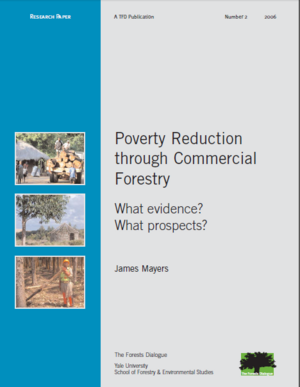Poverty Reduction Through Commercial Forestry: What Evidence? What Prospects?
Two main outcomes for poor households seem to be possible from the use of forest resources: poverty avoidance or mitigation – in which forest resources serve as subsistence ‘safety nets’ (to fall back on in lean times or when crops fail) or low income ‘gap fillers’ (to make a little cash from a few products managed or cultivated as a side-line); and poverty reduction – in which forest resources help lift the household out of poverty by functioning as a source of permanent increases in income, assets, services, civil and political rights, voice and the rule of law. Considerable emphasis in analysis and dialogue has rightly been put on the safety net functions of forests in poor peoples’ lives – and on what forms of management and control of forest resources are appropriate for this. Much less emphasis has been put on the prospects for pulling people out of poverty – and the attention that has been given has tended to focus on the potential of nontimber forest products (and, more recently to a lesser extent, on environmental services). Put simply, there is a widespread assumption that NTFPs are for the poor and timber is for the rich. This paper takes a different tack – it tries to identify what we can conclude about poverty reduction through commercial wood production (hereafter for our purposes called ‘commercial forestry’). It also tries to identify factors, both internal and external to the forest sector, proven to enable
commercial forestry to be pro-poor. It finds little literature that deals directly with the question, but much that helps provide at least part of the answer.
The paper has been prepared for The Forests Dialogue (TFD) and a previous draft was discussed at a “scoping” dialogue with an assembled group of experts held in Richards Bay, South Africa on 19-21 June 2006. The intent of this scoping dialogue was to identify key areas for potential collaboration among stakeholders to catalyze progress towards improving commercial forestry’s contribution to poverty reduction and towards truly sustainable pro-poor initiatives. It brought together representatives from international forestry and development agencies, corporations, NGOs, labour and community groups all interested in working toward this common purpose. This paper has been revised to reflect points made at the scoping dialogue. A full-scale TFD dialogue is now in development for 2007, aimed at generating practical action for a major push to scale up pro-poor commercial forestry.

